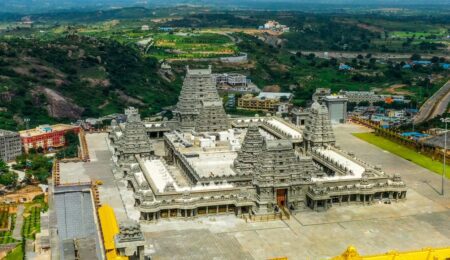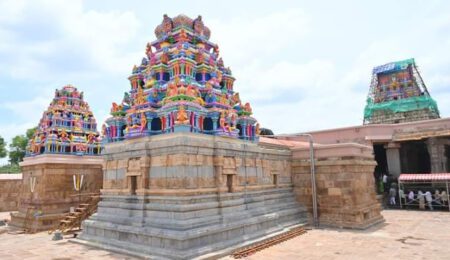Elephanta Caves: Unveiling the Rock-Cut Marvels of Gharapuri Island
Introduction
Elephanta Caves, also known as Gharapuri Caves, are a breathtaking ensemble of rock-cut temples and sculptures perched on Elephanta Island in Mumbai Harbour. Designated a UNESCO heritage site in 1987, the complex offers an unparalleled glimpse into India’s artistic and spiritual legacy.
Nestled just 11 km east of Mumbai’s Gateway of India, Elephanta Island literally “City of Caves” comprises two hillocks separated by a narrow valley, all hewn from solid basalt rock. The remote setting and island landscape create an evocative canvas for some of India’s finest rock-cut architecture and sculptural art.
Most of the five major caves are devoted to Shaivism, celebrating Shiva in his various aspects. Two Buddhist caves with water tanks and stupa mounds attest to earlier Hinayana Buddhist occupation dating as far back as the 2nd century BCE, highlighting the syncretism of Hindu and Buddhist ideas on the island
Today, Elephanta Caves draw travelers, history enthusiasts, and cultural explorers worldwide. This long-form, SEO-optimized article dives deep into their history, architecture, religious significance, practical visitor information, nearby attractions, conservation efforts, and more ensuring you’re fully prepared for an unforgettable journey.
Historical Background
The rock-cut monuments of Elephanta were carved between the mid-5th and 8th centuries CE, a period marked by the decline of Buddhism in India and a revival of Brahmanical traditions. While precise patronage remains debated, scholars link the caves to local dynasties such as the Kalachuris and Silaharas, with inscriptions and stylistic parallels pointing to mid-6th century completion of the main cave.
Early evidence of Buddhist stupas on the island suggests that before cave excavation, Elephanta was a Hinayana Buddhist center. Buried stupa mounds on the eastern hill reinforce the island’s layered religious history, predating the Shaivite cave temples by centuries.
Portuguese colonizers renamed the island “Elephanta” after discovering a colossal elephant sculpture near the shore in the 16th century. Shorn of its religious function under Portuguese rule, the caves suffered vandalism and target practice by soldiers, leaving many sculptures damaged or defaced.
The British assumed control of Elephanta in 1661 but lacked restoration expertise, leaving the site in disrepair until the Archaeological Survey of India took custodianship in 1909 under the Ancient Monuments Preservation Act. Major conservation and consolidation efforts in the 1970s stabilized the fragile rock surfaces and restored structural stability to pillars and facades.
By 1987, UNESCO recognized Elephanta Caves for their outstanding universal value the monumental Trimurti Shiva and other reliefs exemplify a zenith of Indian sculptural creativity and rock-cut architecture. Since inscription, pathways, visitor information centers, and protective measures have enhanced both preservation and visitor experience on the island.
Architectural & Artistic Features
Layout of the Caves
Elephanta Island hosts seven rock-cut caves divided into two distinct clusters. The larger western group contains five Hindu cave temples, while the smaller eastern cluster on Stupa Hill comprises two Buddhist caves complete with water cisterns and chambers.
Cave entrances face west, aligned in a mandala pattern where spatial orientation holds ritual significance. Each cave follows a sarvatobhadra garbhagriha plan square sanctums surrounded by pillared halls (mandapas) and subsidiary chambers a development that influenced later rock-cut architecture across western India.
Highlight: Cave 1 (Great Shiva Cave)
Trimurti Sadashiva
Dominating Cave 1’s rear wall is the colossal 7 m-high Trimurti Sadashiva relief Shiva in three forms: Creator (Vamadeva), Preserver (Mahadeva), and Destroyer (Aghora). The composition captures Shiva’s cosmic functions in a single monolithic sculpture, celebrated as one of Indian art’s supreme masterpieces.
Nataraja
On the north wall stands Shiva as Nataraja, Lord of the Dance. Carved in high relief, the figure’s dynamic pose and rhythmically curved limbs express cosmic cycles of creation and destruction. The surviving upper right hand holds fire, symbolizing renewal, while the lower right is in abhaya mudra, granting protection. High-relief detail on dwarfish attendants and deities surrounding Nataraja enhances the composition’s narrative power.
Ardhanarishvara
East of the Trimurti, Ardhanarishvara embodies the androgynous fusion of Shiva and Parvati. This five-metre relief employs a tribhanga pose three bends to torso, hip, and neck to distinguish masculine and feminine halves. The upper-left hand holds a mirror, and the lower right rests on Nandi’s back. Despite Portuguese damage to the lower portion, devanganas, Kartikeya, Indra, Brahma, and apsaras form a celestial entourage around the central figure.
Gangadhara
Opposite Ardhanarishvara, Gangadhara portrays the descent of the Ganges through Shiva’s matted locks, balancing a scene of terrestrial fertility with Ardhanarishvara’s internal, assimilated creative power. The figure stands in tribhanga, one leg bent, coiffe adorned with crescent moon, and a water pot carved above to depict the life-giving stream’s flow upon the world below.
Andhakasura Vadh
The Andhakasura Vadh relief dramatizes Shiva slaying the demon Andhaka. Shiva, in majestic skiṇdra posture, raises a sword overhead, poised to strike, while Andhaka claws fiercely at the god. The dynamic action, expressive musculature, and swirling draperies underscore the triumph of divine order over destructive forces.
Rock-Cut Style, Pillars, and Carvings
Every cave chamber is supported by basalt columns simple square drums surmounted by cushion capitals—reflecting an early rock-cut style that influenced subsequent cave complexes at Ajanta, Ellora, and other sites. Walls bear high-relief carvings narrating Shiva’s legends and mythic episodes from Puranic texts, while ceilings show traces of once-vibrant pigments, now faded by centuries of weathering and human contact.
Religious & Cultural Significance
Elephanta Caves played a pivotal role in medieval Shaivite and, earlier, Buddhist worship on the island. Pilgrims carved lingas in Cave 1’s sanctum, circled the Shivalinga during rituals, and sought darshan of the Trimurti as an embodiment of Shiva’s cosmic presence.
Annual festivals, most notably Maha Shivaratri, still draw devotees to Elephanta Island for night-long observances and ceremonial boat processions. Temporary shrines near the cave entrances host pujas and cultural performances, sustaining living traditions amid ancient rock carvings.
The iconography on the walls Trimurti, Nataraja, Ardhanarishvara functions as visual scripture, compressing Vedic and Puranic theology into tangible stone, inviting meditation on cosmic creation, preservation, and dissolution.
Buddhist cells in the eastern caves and stupa mounds suggest the island was a center for monastic life before the Shaivite temples emerged. Elephanta thus exemplifies India’s layered religious heritage, where Buddhist and Hindu communities shared sacred space over centuries.
How to Reach Elephanta Caves
By Sea: Ferry from Gateway of India
Ferry services to Elephanta Island depart from the Gateway of India jetty in Mumbai between 9 AM and 2 PM daily, except Mondays when the caves are closed. Boats leave approximately every 30 minutes, and the one-hour voyage offers views of Marine Drive, Colaba coastline, and passing seagulls dancing overhead.
Return ferries from Elephanta begin at noon, with the last departing at 5:30 PM. Tickets for the round-trip ferry cost around ₹120–150 per person, plus ₹10 for upper-deck seating, purchased at the Gateway counter or through authorized agents.
By Rail
Mumbai’s suburban local trains serve Churchgate and Chhatrapati Shivaji Maharaj Terminus (CSMT). From either terminus, a 20-minute walk or a short taxi ride leads to the Gateway of India ferry point. Both stations are major heritage landmarks CST itself a UNESCO heritage site ensuring seamless connectivity for domestic and international travelers.
By Air
The nearest airport is Chhatrapati Shivaji Maharaj International Airport (BOM), well-connected nationally and internationally. Taxis and rideshares from the airport to the Gateway of India take 45 minutes to one hour, depending on traffic, and are widely available outside arrival terminals.
Visitor Guide
Entry Fees
- Indian citizens and BIMSTEC nationals: ₹40 per person
- Foreign tourists: ₹600 per person
- Village entry (all visitors): ₹10 per person
- Children under 15: Free
- Still cameras: No fee
- Video cameras: ₹25 per session
Visiting Hours & Duration
Elephanta Caves are open from 9:00 AM to 5:00 PM Tuesday through Sunday; closed on Mondays. A thorough exploration of the main cave and surrounding shrines takes 2.5–3 hours, including breaks and photography stops.
Best Time to Visit
The ideal season is October–March, when temperatures are milder and skies clearer. Monsoon months (June–September) can bring high tides and choppy seas, leading to ferry cancellations and slippery steps.
Travel Tips & Nearby Attractions
- Wear sturdy, closed-toe shoes and carry light layers cave interiors remain cooler than outside.
- Bring sunscreen, a hat, and insect repellent, especially during midday sun.
- Carry bottled water and snacks; few vendors operate on the island. Dispose of waste responsibly.
- Beware of inquisitive monkeys near the jetty; secure belongings.
- Network coverage may be weak; download maps and emergency contacts beforehand.
Nearby Attractions
- Gateway of India – Iconic arch facing the Arabian Sea, ideal for sunrise and sunset.
- Colaba Causeway – Bustling street market for handicrafts, textiles, and street food.
- Marine Drive – The “Queen’s Necklace” promenade, perfect for evening strolls.
- Chhatrapati Shivaji Maharaj Vastu Sangrahalaya – Former Prince of Wales Museum, hosting Indo-Saracenic architecture and rich artifact collections.
- Kanheri Caves – Buddhist rock-cut caves in Sanjay Gandhi National Park, offering serene jungle ambience.
Conservation & UNESCO Preservation
Since inscription in 1987, UNESCO and the Archaeological Survey of India (ASI) have collaborated on a Conservation Management Plan guiding restoration activities. These include stabilizing rock faces, consolidating fallen pillars, repairing collapsed facades, constructing protective pathways, and establishing visitor facilities—all while preserving the site’s authenticity.
Regular monitoring addresses saline erosion and rock surface deterioration. Protective canopies and restricted‐access zones shield vulnerable carvings, and interpretive signage educates visitors on preserving this living heritage.
The ASI’s “Adopt a Heritage” 2.0 scheme has further enhanced site amenities through private-sector CSR, without altering entry ticketing or pricing, ensuring revenues support ongoing conservation and visitor services.
FAQs
Why is it called Elephanta Caves? Portuguese colonizers named the island “Elephanta” after discovering a massive elephant sculpture near the old landing site; the local Marathi name remains Gharapuri, “City of Caves” .
How old are the caves? Archaeological evidence places cave construction between the mid-5th and 8th centuries CE, with major works on the main Shiva Cave largely complete by the mid-6th century.
What is the significance of the Trimurti Shiva sculpture? The 7 m-high Trimurti Sadashiva embodies Shiva’s cosmic roles—Creator, Preserver, Destroyer—in a single monolithic relief, exemplifying a pinnacle of aesthetic and spiritual expression in Indian rock-cut art.
Conclusion
Elephanta Caves stand as a must-visit heritage site in India, marrying dramatic island scenery with sublime examples of rock-cut architecture and sculpture. From the monumental Trimurti Shiva to the androgynous Ardhanarishvara, each relief invites reflection on cosmic cycles, divine unity, and human creativity.
Whether you’re a traveler seeking cultural immersion, a history buff tracing medieval dynasties, or a spiritual seeker drawn to Shaivite and Buddhist legacies, Elephanta Caves deliver an unforgettable journey. Plan your ferry crossing at dawn, wander through cool basalt halls, and witness UNESCO heritage at its finest an island sanctuary of art, myth, and devotion.




Leave a Comment